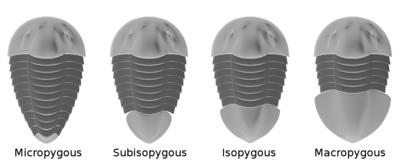|
Pygidium The pygidium (pl.: pygidia) is the posterior body part or shield of crustaceans and some other arthropods, such as insects and the extinct trilobites. In groups other than insects, it contains the anus and, in females, the ovipositor. It is composed of fused body segments, sometimes with a tail, and separated from thoracic segments by an articulation.[1] CheliceratesIn arachnids, the pygidium is formed by reduction of the last three opisthosomal segments to rings where there is no distinction between tergites and sternites. A pygidium is present in Palpigradi, Amblypygi, Uropygi, Schizomida, Ricinulei and in the extinct order Trigonotarbida. It is also present in early fossil representatives of horseshoe crabs. TrilobitesThe pygidium of Kolihapeltis is strikingly heteronomous, while that of Phacops is homonomous. Both are subisopygous. In trilobites, the pygidium can range from extremely small (much smaller than the head, or cephalon) to larger than the cephalon. They can be smooth, as in order Asaphida, or spiny, as in order Lichida. They can be classified into four categories according to their relative size in comparison to the cephalon.[2]
They can further be subdivided in their morphological similarity to the thorax. Pygidia that are similar in shape and form to the thoracic segments are termed homonomous, while pygidia that vary significantly from the shape and form of the thoracic segments (like by the presence or absence of spines) are heteronomous.  InsectsIn insects, the pygidium is the dorsal tergite of the last external abdominal segment.[3] Other usesPygidium is also a superseded genus of fish of the family Trichomycteridae. Most species of this genus have been reassigned to the genus Trichomycterus. See alsoReferences
External links |
Portal di Ensiklopedia Dunia

